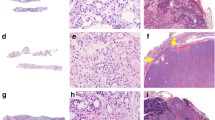Abstract
Background
The newly termed tumor ‘noninvasive follicular thyroid neoplasm with papillary-like nuclear features’ (NIFTP) acts in an indolent manner and can likely be safely managed with a thyroid lobectomy. Preoperative fine-needle aspiration (FNA) is the cornerstone of surgical planning, but the ability of FNA to distinguish NIFTP from other variants of papillary thyroid carcinoma (PTC) has not been well-evaluated.
Methods
A 9-year retrospective review of the preoperative cytology and surgical pathology of PTC patients who underwent a thyroidectomy at our tertiary referral center.
Results
Overall, 174 patients with 177 PTCs had a preoperative FNA followed by a thyroidectomy, and met our inclusion criteria. Of the 21 patients with NIFTP, the preoperative cytology was read as malignant in three (14%), suspicious for malignancy in three (14%), follicular neoplasm in ten (48%), atypia of undetermined significance in four (19%), and benign in one (5%) nodule. When comparing patients with NIFTP with other variants of PTC, patients with NIFTP were younger (p = 0.023) and less likely to have malignant cytology (p < 0.001). On multivariable regression modeling, malignant cytology was independently associated with a decreased risk of a final diagnosis of NIFTP (odds ratio 0.064, 95% confidence interval 0.018–0.233, p < 0.001).
Conclusions
Patients with a final diagnosis of NIFTP are less likely to have preoperative FNA diagnosis of malignancy than those with final pathology of classical or other variants of PTC. Surgeons should take this into consideration when considering between a lobectomy and total thyroidectomy for patients with suspected PTC.
Similar content being viewed by others
References
Boring CC, Squires TS, Tong T. Cancer statistics, 1991.CA Cancer J Clin. 1991;41(1):19–36.
Bilimoria KY, Bentrem DJ, Ko CY, et al. Extent of surgery affects survival for papillary thyroid cancer. Ann Surg. 2007;246(3):375–81.
Davies L, Welch HG. Increasing incidence of thyroid cancer in the United States, 1973–2002. JAMA. 2006;295:2164–2167.
Jung CK, Little MP, Lubin JH, et al. The increasein thyroid cancer incidence during the last four decades is accompanied by a high frequency of BRAF mutations and a sharp increase in RAS mutations. J Clin Endocrinol Metab. 2014;99(2):E276–E285.
Liu J, Singh B, Tallini G, et al. Follicular variant of papillary thyroid carcinoma: a clinicopathologic study of a problematic entity. Cancer. 2006;107(6):1255–64.
Daniels GH. What if many follicular variant papillary thyroid carcinomas are not malignant? A review of follicular variant papillary thyroid carcinoma and a proposal for a new classification. Endocr Pract. 2011;17(5):768–87.
Lloyd RV, Erickson LA, Casey MB, et al. Observer variation in the diagnosis of follicular variant of papillary thyroid carcinoma. Am J Surg Pathol. 2004;28(10):1336–40.
Nikiforov YE, Seethala RR, Tallini G, et al. Nomenclature revision for encapsulated follicular variant of papillary thyroid carcinoma: a paradigm shift to reduce overtreatment of indolent tumors. JAMA Oncol. 2016;2(8):1023–9.
Cibas ES, Ali SZ. The bethesda system for reporting thyroid cytopathology. Am J Clin Pathol. 2009;132(5):658–65.
Renshaw AA. Focal features of papillary carcinoma of the thyroid in fine-needle aspiration material are strongly associated with papillary carcinoma at resection. Am J Clin Pathol. 2002;118(2):208–10.
Ustun B, Chhieng D, Prasad ML, et al. Follicular variant of papillary thyroid carcinoma:accuracy of FNA diagnosis and implications for patient management. Endocr Pathol. 2014;25(3):257–64.
Baloch ZW, Gupta PK, Yu GH, et al. Follicular variant of papillary carcinoma. Cytologic and histologic correlation. Am J Clin Pathol. 1999;111(2):216–22.
Wu HH, Jones JN, Grzybicki DM, et al. Sensitive cytologic criteria for the identification of follicular variant of papillary thyroid carcinoma in fine-needle aspiration biopsy. Diagn Cytopathol. 2003;29(5):262–6.
Strickland KC, Howitt BE, Marqusee E, et al. The impact of noninvasive follicular variant of papillary thyroid carcinoma on rates of malignancy for fine-needle aspiration diagnostic categories. Thyroid. 2015;25(9):987–92.
Strickland KC, Vivero M, Jo VY, et al. Preoperative cytologic diagnosis of noninvasive follicular thyroid neoplasm with papillary-like nuclear features: a prospective analysis. Thyroid. 2016;26(10):1466–1471.
Haugen BR, Alexander EK, Bible KC, et al. 2015 American thyroid association management guidelines for adult patients with thyroid nodules and differentiated thyroid cancer: the american thyroid association guidelines task force on thyroid nodules and differentiated thyroid cancer. Thyroid. 2016;26(1):1–133.
Rivera M, Ricarte-Filho J, Knauf J et al. Molecular genotyping of papillary thyroid carcinoma follicular variant according to its histological subtypes (encapsulated vs. infiltrative) reveals distinct BRAF and RAS mutation patterns. Mod Pathol. 2010;23(9):1191–200.
Ibrahim AA, Wu HH. Fine-needle aspiration cytology of noninvasive follicular variant of papillary thyroid carcinoma is cytomorphologically distinct from the invasive counterpart. Am J Clin Pathol. 2016;146(3):373–7.
Maletta F, Massa F, Torregrossa L, et al. Cytological features of “noninvasive follicular thyroid neoplasm with papillary-like nuclear features” and their correlation with tumor histology. Hum Pathol. 2016;54:134–42.
Funding
Department funds were used for incidental expenses.
Conflicts of interest
Richa Singh, Jorge Avila, Kahee Jo, Kevin T.K. Nguyen, Nika Roa Carrillo, Eric C. Huang, and Michael J. Campbell have no conflicts of interest to disclose.
Author information
Authors and Affiliations
Corresponding author
Rights and permissions
About this article
Cite this article
Singh, R., Avila, J., Jo, K. et al. Patients with Non-invasive Follicular Thyroid Neoplasm with Papillary-Like Nuclear Features are Unlikely to have Malignant Preoperative Cytology. Ann Surg Oncol 24, 3300–3305 (2017). https://doi.org/10.1245/s10434-017-6038-5
Received:
Published:
Issue Date:
DOI: https://doi.org/10.1245/s10434-017-6038-5




